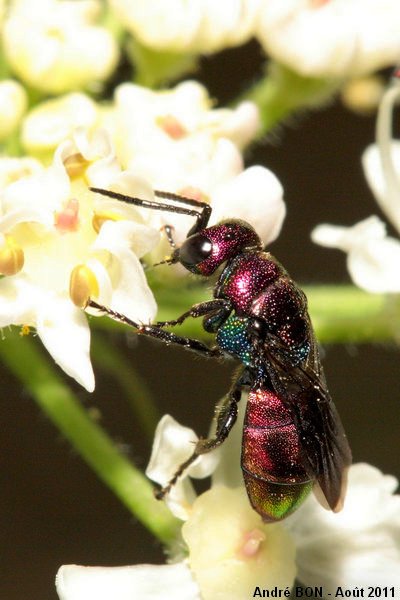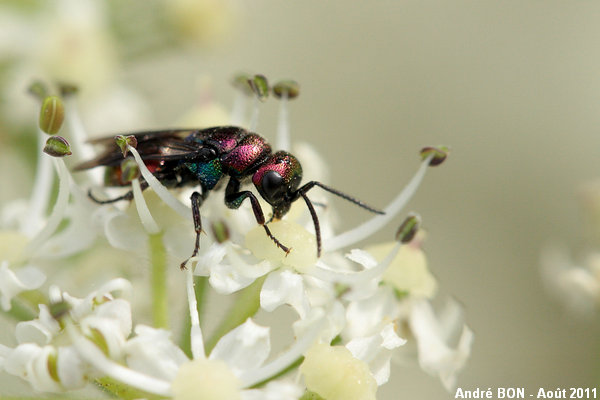


| Hedychrum rutilans (Dahlbom, 1854) |



|
|
Scientific name: Hedychrum rutilans (Dahlbom, 1854) Common name: French name: Order: Hymenoptera Family: Chrysididae Wingspan : 5.5-9.5 mm. Biotope: Sunny areas with flowers, sandy areas where the nests of the victim species are located. Geographic area: Europe, North Africa. Observation period : Late June to September. |
Chrysididae are small hymenopteran wasps with beautiful metallic colours. They are parasitoids of other insects. As they are used to laying their eggs in the nest of these other insects, they are called cuckoo wasps. Hedychrum rutilans belongs to the Chrysidinae subfamily. The members of the other subfamily, Cleptinae, only show metallic colours on the front parts of the body. The abdomen has only three visible segments. The four last ones are folded inside. Telling species apart is very difficult. There are about 60 Chrysididae species in the Paris Basin. The Hedychrum genus is characterized by a wide and flattened body, two small lateral teeth on the third tergite and by the bifid tarsi tip. Hedychrum rutilans generally shows a three-coloured body with a rather lengthy abdomen and a strongly punctuated thorax. The head and the front part of the thorax are golden green on males and shiny purple pink with green sheen on females. The back part of the thorax is dark blue or green. The abdomen is golden or pink. Hedychrum rutilans parasitoids solitary wasps of the Philanthus genus by laying eggs on the paralyzed honeybees carried by the wasps to feed their larvae. The Hedychrum rutilans larva will eat the honeybee then the wasp larva. Female Hedychrum chalybaeum can also show similar colours but its abdomen is much shorter. |
| [To know more about the Hedychrum rutilans] [Next picture] [Top] |

|
I have observed many of theses Chrysididae on umbellifers. On this picture you can see the small lateral tooth on the third tergite. The abdomen is rather long. |
| [To know more about the Hedychrum rutilans] [Next picture] [Previous picture] [Top] |

|
On this picture you can see the bifid tarsi tip. The identification of the Hedychrum genus is confirmed. |
| [To know more about the Hedychrum rutilans] [Previous picture] [Top] |

|
I have told Hedychrum rutilans apart based on the global colours. It would be great to get confirmation by an expert. |